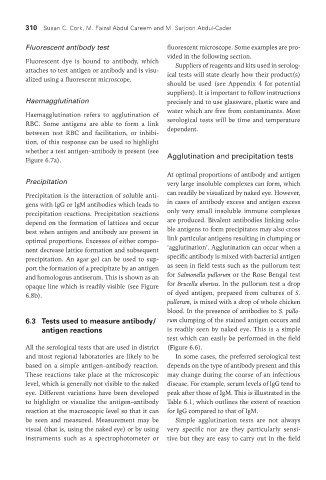Page 341 - The Veterinary Laboratory and Field Manual 3rd Edition
P. 341
310 Susan C. Cork, M. Faizal Abdul Careem and M. Sarjoon Abdul-Cader
Fluorescent antibody test fluorescent microscope. Some examples are pro-
vided in the following section.
Fluorescent dye is bound to antibody, which Suppliers of reagents and kits used in serolog-
attaches to test antigen or antibody and is visu- ical tests will state clearly how their product(s)
alized using a fluorescent microscope.
should be used (see Appendix 4 for potential
suppliers). It is important to follow instructions
Haemagglutination precisely and to use glassware, plastic ware and
water which are free from contaminants. Most
Haemagglutination refers to agglutination of
RBC. Some antigens are able to form a link serological tests will be time and temperature
between test RBC and facilitation, or inhibi- dependent.
tion, of this response can be used to highlight
whether a test antigen–antibody is present (see
Figure 6.7a). agglutination and precipitation tests
At optimal proportions of antibody and antigen
Precipitation very large insoluble complexes can form, which
Precipitation is the interaction of soluble anti- can readily be visualized by naked eye. However,
gens with IgG or IgM antibodies which leads to in cases of antibody excess and antigen excess
precipitation reactions. Precipitation reactions only very small insoluble immune complexes
depend on the formation of lattices and occur are produced. Bivalent antibodies linking solu-
best when antigen and antibody are present in ble antigens to form precipitates may also cross
optimal proportions. Excesses of either compo- link particular antigens resulting in clumping or
nent decrease lattice formation and subsequent ‘agglutination’. Agglutination can occur when a
precipitation. An agar gel can be used to sup- specific antibody is mixed with bacterial antigen
port the formation of a precipitate by an antigen as seen in field tests such as the pullorum test
and homologous antiserum. This is shown as an for Salmonella pullorum or the Rose Bengal test
opaque line which is readily visible (see Figure for Brucella abortus. In the pullorum test a drop
6.8b). of dyed antigen, prepared from cultures of S.
pullorum, is mixed with a drop of whole chicken
blood. In the presence of antibodies to S. pullo-
6.3 Tests used to measure antibody/ rum clumping of the stained antigen occurs and
antigen reactions is readily seen by naked eye. This is a simple
test which can easily be performed in the field
All the serological tests that are used in district (Figure 6.6).
and most regional laboratories are likely to be In some cases, the preferred serological test
based on a simple antigen–antibody reaction. depends on the type of antibody present and this
These reactions take place at the microscopic may change during the course of an infectious
level, which is generally not visible to the naked disease. For example, serum levels of IgG tend to
eye. Different variations have been developed peak after those of IgM. This is illustrated in the
to highlight or visualize the antigen–antibody Table 6.1, which outlines the extent of reaction
reaction at the macroscopic level so that it can for IgG compared to that of IgM.
be seen and measured. Measurement may be Simple agglutination tests are not always
visual (that is, using the naked eye) or by using very specific nor are they particularly sensi-
instruments such as a spectrophotometer or tive but they are easy to carry out in the field
Vet Lab.indb 310 26/03/2019 10:26

